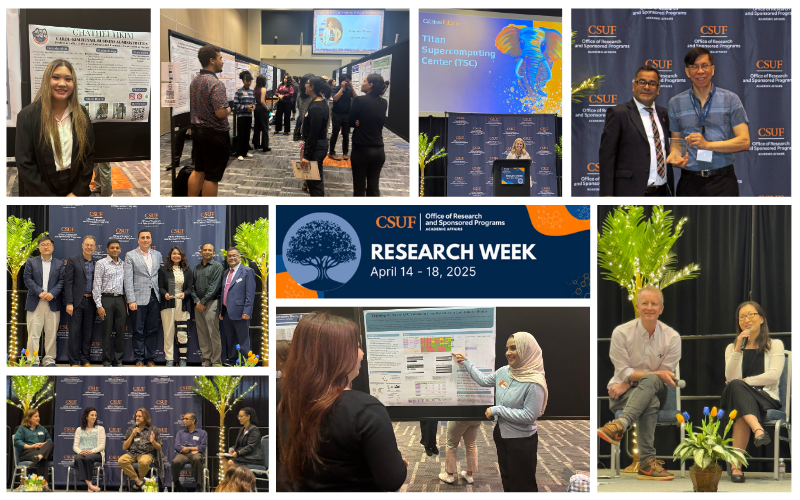
For many Cal State Fullerton students, Research Week wasn’t just a series of lectures and panels from April 14-18 — it was a week of discovery. From navigating the Institutional Review Board process to presenting original research at the Student Creative Activities and Research Day, students had the opportunity to see themselves as scholars, innovators and collaborators.
“There were so many opportunities for students throughout the week,” said Rumneysa Gurier, a biochemistry major who attended several Research Week events. “Even sessions that weren’t directly related to my field helped me think about my research in new ways. It made me feel like I was part of something bigger.”
Held annually each April and hosted by the Office of Research and Sponsored Programs, Research Week brought energy to campus as students, staff and faculty came together to celebrate scholarship and strengthen collaborative efforts.
“At Cal State Fullerton, we take pride in being one of the few institutions that not only promotes graduate-level research and creative activities, but also strongly supports undergraduate research and creative engagement,” said Binod Tiwari, associate vice president for research and sponsored programs. “We want our students to be involved in opportunities that inspire curiosity and lead to meaningful impact.”
But the impact of Research Week 2025 extended beyond the student experience. Faculty and staff also found it to be a space for reflection, mentorship and collaboration.
“Research Week is a fantastic opportunity for faculty to learn about the various resources available to support our research and creative projects,” said Joe Carlin, associate professor of geological sciences. “From funding opportunities to proposal development, it’s a chance to discover how we can strengthen our own work and, ultimately, enhance the educational experiences available to our students.”
The weeklong series consisted of workshops, lectures, lightning talks from various CSUF centers and institutes, and panels, all of which highlighted the breadth of inquiry occurring at CSUF while also encouraging new avenues for funding, collaboration and student participation.
A key highlight was the L. Don Shields Excellence in Scholarship and Creativity Award lecture, delivered by Math Cuajungco, professor of biological science. His lecture, “Zinc, Protein Function and Brain Diseases,” explored the critical role of zinc in brain function and the research his lab —comprising both undergraduate and graduate students — is conducting to understand its implications for neurodegenerative disorders.
“This lecture helped me understand how something that isn’t even in my field of study can still be relevant and fascinating,” said Gurier. “There’s just so much great work happening here on campus — it really opened my eyes.”
Several sessions concentrated on supporting both early-stage and experienced researchers. For instance, one event focused on navigating research compliance, which provided attendees with guidance on IRB procedures and emphasized how to meet university, state and federal standards.
“As a graduate student in the process of submitting my IRB paperwork, I found the information incredibly helpful,” said Sameha Elamoudi, a counseling graduate student. “It clarified the steps and expectations and made the process feel far more approachable.”
A sense of cross-campus collaboration also permeated the week. Nowhere was this more apparent than in the faculty panel on “Engaging Students in Research and Creative Activities,” where faculty from across disciplines shared insights into mentoring undergraduate and graduate students, developing impactful research questions and integrating student work into competitive grant proposals.
“I appreciated the chance to connect with colleagues from different departments and collaborate with them on engaging students,” noted Carlin, who served as a panelist for the event. “It provided a great platform for us to exchange ideas and strategies on how to involve students more deeply in our work and empower those students to make meaningful contributions to our projects.”
That spirit of collaboration was also exemplified by the Titans Thinking Together, or T3 initiative, which was spotlighted during the week as a model for interdisciplinary research. T3 brings faculty from different colleges together to tackle pressing societal issues through cross-college, collaborative projects. By providing seed funding and structural support, the initiative fosters partnerships that transcend traditional academic boundaries — an approach echoed throughout the week’s programming.
The week culminated in SCAR Day, one of the most anticipated and inspiring events of the year. Hosted by the Undergraduate Research Opportunity Center, SCAR Day featured student poster and oral presentations that reflected a remarkable array of creativity and scholarly depth. For many students, it was their first opportunity to formally present their research to the campus community.
“I met so many students who had taken a project from idea to completion for the first time,” reflected Gurier. “You could really see how proud they were to share their work — it was exciting to witness that sense of accomplishment from your peers.”
As students presented their research and faculty and staff shared their expertise, Research Week highlighted the strength of CSUF’s campus community that is committed to scholarship, mentorship and innovation. The events of the week not only recognized the achievements of the present but also encouraged future collaborations, emphasizing the value of bringing together diverse perspectives to enhance impacts.
For more information, or to explore resources from this year’s Research Week, visit the Office of Research and Sponsored Programs website.